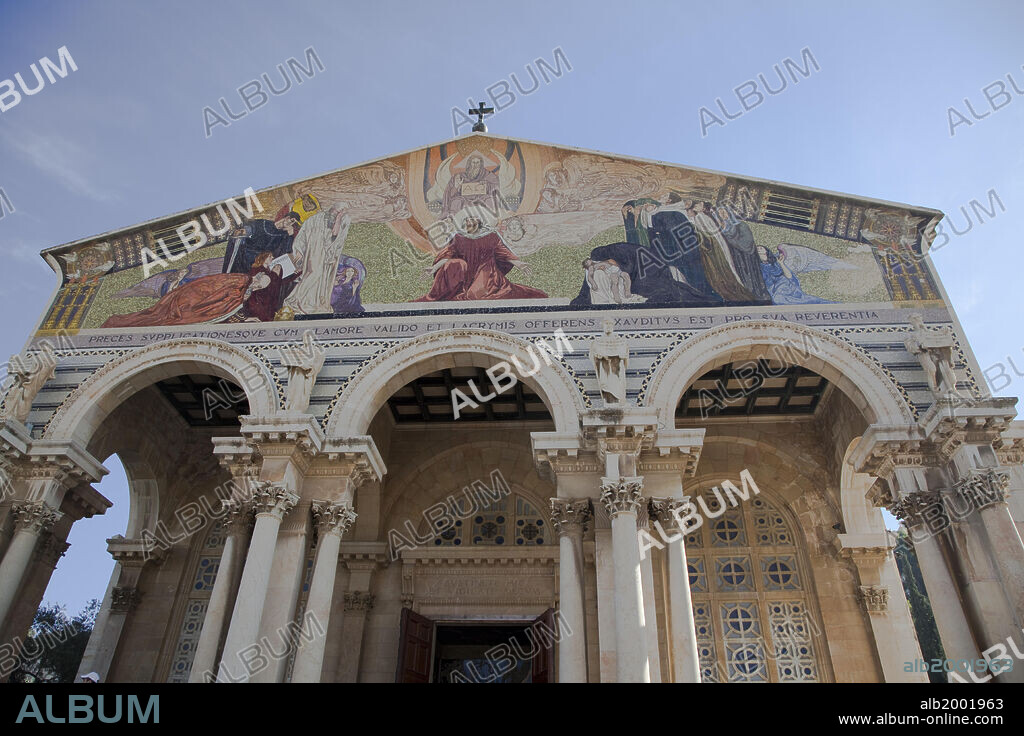alb2001963
Israel, Jerusalem-Church of All Nations, facade

|
Zu einem anderen Lightbox hinzufügen |
|
Zu einem anderen Lightbox hinzufügen |



Haben Sie bereits ein Konto? Anmelden
Sie haben kein Konto? Registrieren
Dieses Bild kaufen.
Nutzung auswählen:

Titel:
Israel, Jerusalem-Church of All Nations, facade
Untertitel:
Siehe automatische Übersetzung
The Church of All Nations, officially named the Basilica of the Agony, is located at the base of the Mount of Olives in Jerusalem. Next to the Garden of Gethsemane that is thought to be where Jesus prayed on the night of his arrest (Matthew 26:36). The Basilica of the Agony was built between 1919 -1924 using funds from 12 different countries. Therefore, it was called the Church of All Nations. The Church has a domed roof, thick pillars, and floor mosaic reminiscent of the Byzantine period. The architect of the building was Antonio Barluzzi. The symbols of the 12 different countries are incorporated into the gold ceilings of 12 cupolas. The 12 cupolas rest on six monolithic pillars. The front of the church features a colorful facade held up by a row of pillars. The mosaic above the entrance depicts Christ as the link between God and humanity. The Church of All Nations is run by the Franciscans. The Church of All Nations lies on the foundations of two earlier churches: a 12th-century Crusader chapel abandoned in 1345 and a 4th-century Byzantine basilica, destroyed by an earthquake in 746.
Bildnachweis:
Album / Sites and Photos
Freigaben (Releases):
Model: Nein - Eigentum: Nein
Rechtefragen?
Rechtefragen?
Bildgröße:
5616 x 3744 px | 60.2 MB
Druckgröße:
47.5 x 31.7 cm | 18.7 x 12.5 in (300 dpi)
Schlüsselwörter:
APOSTEL, SCHLAFEND, OELBERG • ARCHITEKTUR • ARCHITEKTUR: FASSADE • AUßEN • CHRISTENTUM • CHRISTUS AM OELBERG • CHRISTUS AM OLBERG • CHRISTUS AM ÖLBERG • CHRISTUS GETHSEMANE • CHRISTUS OELBERG, GEBET • CHRISTUS • COLUMN • DRAUßEN • ECCLESIA • FASSADE • FENSTER • GEBAUEDEVORDERSEITE • GETHSEMANE • GEZEMANEH • GOETTER • GOTT • HAUPTSTADT • HORIZONTALE • IM FREIEN (ALLGEMEIN) • INNENRAEUME: KIRCHEN • ISRAEL • JERUSALEM • JERUSALEM, STADTANSICHT • JESUS • KIRCHE • KIRCHEN • KREUZ • MOSAIK • OELBERG, GARTEN • OELBERG, GEBET • PASSION: GETHSEMANE • PFEILER • PLASTIKEN • SAEULE • SCHLAFENDE APOSTEL • SKULPTUR • SKULPTUREN • STADTANSICHT: JERUSALEM • STEILPERSPEKTIVE • SÄULE • SÄULEN • TAG • TECHNIK: SKULPTUR • TROMMELFELL • TYMPANON • TYMPANUM • WALLFAHRT • WÖLBUNG
 Pinterest
Pinterest Twitter
Twitter Facebook
Facebook Link kopieren
Link kopieren Email
Email
